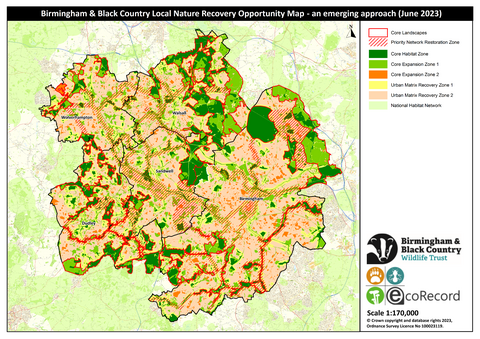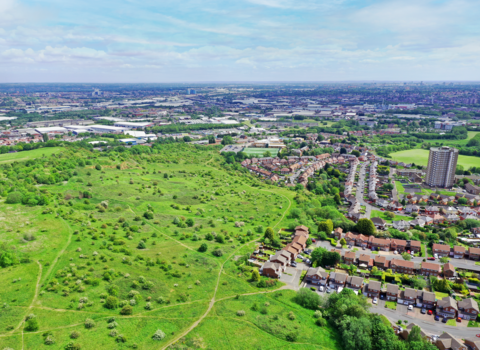Shaping the Future of Nature Recovery
Local Nature Recovery Strategies (LNRS) are a flagship measure in the Environment Act. They are a new system of spatial strategies for nature which will plan, map, and help drive more coordinated, practical, focussed action and investment in nature’s recovery to build the national Nature Recovery Network.
The Birmingham & Black Country Wildlife Trust and EcoRecord (the Local Environmental Record Centre for Birmingham and the Black Country) have been commissioned by the four Black Country local authorities (Dudley MBC, Sandwell MBC, Walsall MBC and Wolverhampton City Council, supported by the Black Country Consortium) to undertake an analysis of evidence to produce a draft Local Nature Recovery map and develop the Local Nature Recovery Strategy (LNRS) approach for the Black Country.
The development of a Nature Recovery Network (NRN) covering the whole of England is a major commitment in the Government’s 25 Year Environment Plan (2018). The plan states that the development of the NRN will provide 500,000 hectares of additional wildlife habitat, more effectively linking existing protected sites and landscapes, as well as urban green and blue infrastructure; and that as well as helping wildlife thrive, the NRN could be designed to bring a wide range of additional benefits: greater public enjoyment; pollination; carbon capture; water quality improvements and flood management.
The Government have stated that establishing the NRN will help deal with three of the biggest challenges society faces: biodiversity loss, climate change and wellbeing (Defra, 2020), and will:
- Enhance sites designated for nature conservation and other wildlife-rich places - newly created and restored wildlife-rich habitats, corridors and stepping stones will help wildlife populations to grow and move.
- Improve the landscape’s resilience to climate change, providing natural solutions to reduce carbon and manage flood risk, and sustaining vital ecosystems such as improved soil, clean water and clean air.
- Reinforce the natural and cultural diversity of our landscapes, and protect our historic natural environment.
- Enable us to enjoy and connect with nature where we live, work and play - benefiting our health and wellbeing.
Black Country Local Nature Recovery Map and Strategy: An Emerging Approach
The key tasks of our commission are to develop a habitat baseline for the Black Country, produce a draft Nature Recovery Map for the Black Country, produce a draft Black Country Local Nature Recovery Opportunity Map and develop draft Priority Biodiversity Actions (Statement of Biodiversity Priorities).
You can now read our initial report which presents the methodology developed to date, as well as a series of map images and tabulated outputs that represent the approach and direction taken.

Core Landscapes
Core Landscapes are large areas of land comprised of multiple land use parcels that are ecologically coherent, often sharing similar geology, soil types, habitats, landscape character and landuse history. They are frequently those areas less impacted upon by urban development and often support features more typically associated with rural landscapes. Core Landscapes typically support the highest abundance and diversity of semi-natural and Priority Habitats, and the species assemblages associated with these. They provide significant opportunity and are a priority for investment in ecological recovery (e.g. habitat restoration and creation).
Priority Network Restoration Zone
Priority Network Restoration Zones are areas where investment in ecological recovery outside of Core Landscapes has been prioritised. These zones have been selected on the basis of being those areas that contain the highest density of Core Habitat and Core Expansion land use parcels which collectively link Core Landscapes (or their component parts), and their purpose is to support the creation of a coherent ecological network across the Black Country landscape. Priority Network Restoration Zones comprise the full range of landscape components (natural and built environment) and, where these exist, follow linear blue and green corridors (e.g. canals, rivers and dismantled railway lines).
Core Habitat Zone
The Core Habitat Zone is comprised of the land use parcels that contain the most ecologically valuable habitats. The zone includes all parcels with an ecological value score of 4 or above (see ecological evaluation methodology); all sites with a nature conservation designation not included in the above (e.g. some Sites of Local Importance for Nature Conservation); and any additional areas identified in Natural England’s Combined Habitat Network data set. The Core Habitat Zone is a priority for protection and restoration.
Core Expansion Zone 1
Core Expansion Zone 1 comprises those land use parcels that are of lower ecological value than those in the Core Habitat Zone but, due to inherent value or location, have the most potential to contribute to a coherent ecologic network. These sites are frequently within Core Landscapes and Priority Network Restoration Zones and are a priority for investment in the restoration and creation of new habitats. Included in this zone are all areas of green space scoring 3 in the ecological evaluation; all green space scoring 1 or 2 lying within 150 metres of a Core Habitat Zone; those areas identified as habitat bottlenecks; and vegetated railway cuttings and embankments.
Core Expansion Zone 2
Core Expansion Zone 2 comprises all areas of greenspace that do not meet the criteria for inclusion in Zone 1. These sites provide an opportunity for the restoration and creation of new habitats but investment in these areas is a lower priority than in Zone 1.
Urban Matrix Recovery Zone 1
Urban Matrix Recovery Zone 1 comprises all features of the built environment within 150 metres of the Core Habitat Zone, and may include residential and commercial properties, gardens, road verges, street trees and minor watercourses. Due to their proximity to sites of ecological value these features have the most potential of their type to contribute to a coherent ecologic network. The protection, enhancement and creation of green infrastructure within these areas is a priority.
Urban Matrix Recovery Zone 2
Urban Matrix Recovery Zone 2 comprises all features of the built environment outside of Zone 1. These areas provide an opportunity for the protection, enhancement and creation of green infrastructure but investment in these areas is of a lower priority than in Zone 1.
National Habitat Network
Natural England’s Combined Habitat Networks data set.

